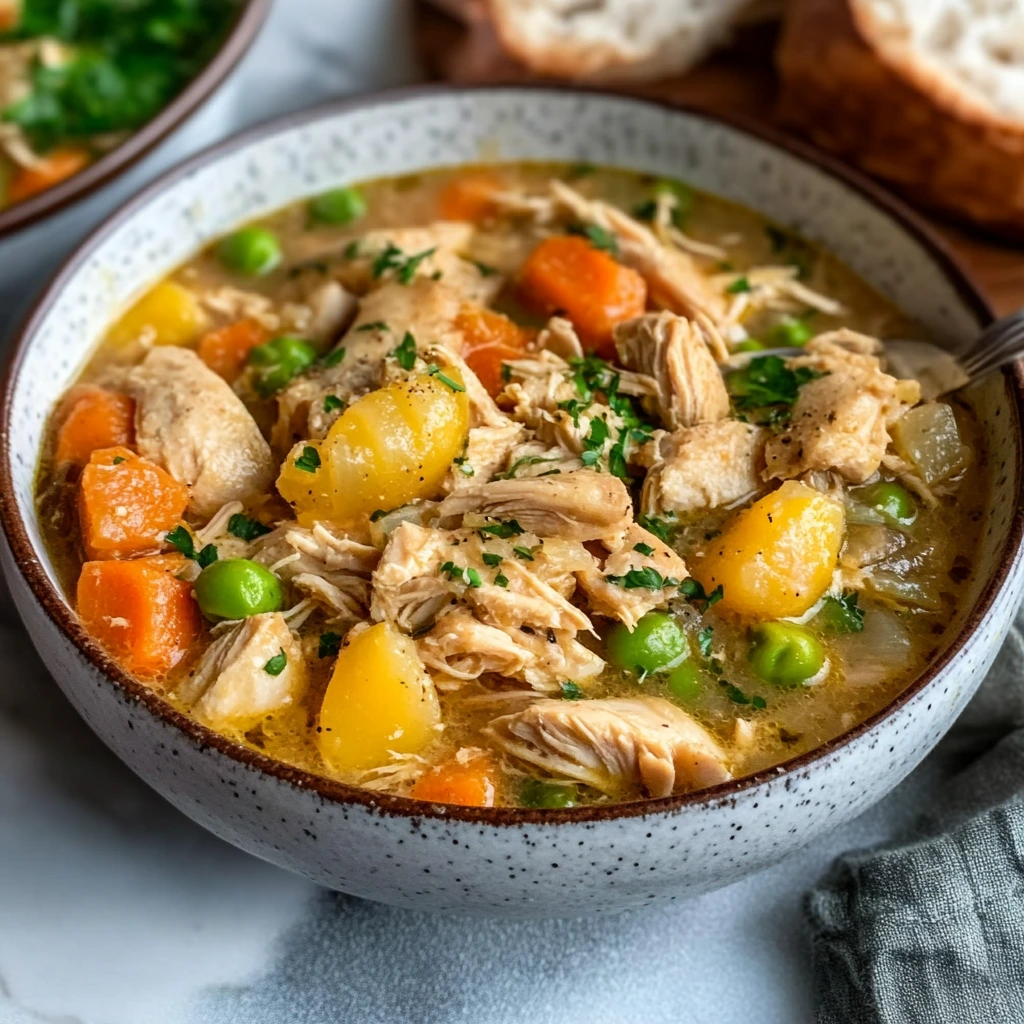Slow cooker chicken stew is a timeless comfort food that combines rich flavors, tender chicken, and hearty vegetables in a single pot. This dish is not only easy to prepare but also perfect for busy individuals who crave a home-cooked meal without spending hours in the kitchen.
In this article, we will reveal the seven ultimate secrets to making the perfect slow cooker chicken stew, ensuring every bite is bursting with flavor. Along the way, you’ll also discover the history of slow cooking, the best ingredients to use, and pro tips to enhance your stew-making skills.
Table of Contents
History of Slow Cooking
Slow cooking dates back thousands of years, long before the invention of modern appliances. Ancient civilizations used clay pots and earthenware vessels to cook food slowly over an open flame or buried in hot coals. This method allowed meats and vegetables to simmer gently, developing deep, rich flavors while preserving nutrients.
In the early 20th century, the concept of slow cooking evolved with the invention of the Crock-Pot in the 1970s. Originally designed to cook beans, this electric slow cooker quickly gained popularity for its ability to prepare a variety of meals with minimal effort. Today, slow cookers are a staple in many kitchens, helping home cooks create delicious, hearty meals with ease.
Key Ingredients and Nutritional Benefits
A great slow cooker chicken stew starts with high-quality ingredients that not only enhance the flavor but also provide essential nutrients. Here’s a breakdown of the key components and their health benefits:
1. Chicken (Protein Powerhouse)
- Best cuts: Boneless, skinless chicken thighs or breasts
- Why it’s essential: Chicken is a lean protein source that supports muscle growth and keeps you full longer. Dark meat (thighs) provides extra juiciness and flavor.
2. Vegetables (Nutrient Boosters)
- Carrots: Rich in beta-carotene, promoting eye health and adding natural sweetness.
- Celery: High in antioxidants and fiber for digestion.
- Onions & Garlic: Boost immunity and enhance depth of flavor.
- Potatoes or Sweet Potatoes: Provide fiber and complex carbohydrates for energy.
3. Broth (Flavorful & Hydrating)
- Chicken broth or stock: Adds richness while keeping the stew moist.
- Health benefit: Supports gut health and hydration with minerals like calcium and magnesium.
4. Herbs & Spices (Flavor Enhancers)
- Thyme & Rosemary: Offer earthy notes and anti-inflammatory benefits.
- Bay Leaves: Infuse a subtle depth of flavor.
- Salt & Black Pepper: Balance the taste and highlight natural ingredients.
5. Thickening Agents (Creamy Texture)
- Flour, cornstarch, or mashed potatoes: Help create a rich and velvety stew consistency.
- Dairy options (if preferred): A splash of cream can add extra indulgence.

Step-by-Step Cooking Process
Step 1: Gather & Prep Ingredients
- Chop vegetables: Cut carrots, celery, potatoes, and onions into bite-sized pieces.
- Prepare chicken: Trim excess fat and cut into chunks (if desired) or leave whole for shredding later.
- Measure seasonings: Having spices and herbs ready ensures an even flavor distribution.
Step 2: Sear the Chicken (Optional, but Recommended)
- Why? Searing locks in juices and adds a rich, caramelized flavor.
- Heat oil in a pan, brown chicken on both sides, then transfer to the slow cooker.
Step 3: Layer Ingredients in the Slow Cooker
- Bottom layer: Root vegetables (potatoes, carrots) – these take longer to cook.
- Middle layer: Celery, onions, and garlic.
- Top layer: Seared chicken and fresh herbs.
- Pour in broth to cover the ingredients.
Step 4: Slow Cook to Perfection
- Cooking times:
- Low setting: 6–8 hours (best for deep flavors).
- High setting: 3–4 hours (for a quicker meal).
- Pro Tip: Avoid opening the lid too often – this slows down the cooking process!
Step 5: Adjust Consistency & Final Seasoning
- If too thin: Mix cornstarch with water and stir in to thicken.
- If too thick: Add a bit more broth.
- Taste test: Adjust salt, pepper, or herbs as needed.
Step 6: Serve & Enjoy!
- Garnish with fresh parsley or a squeeze of lemon for extra brightness.
- Pair with warm bread, rice, or a side salad for a complete meal.
Variations and Adaptations
One of the best things about slow cooker chicken stew is its versatility! You can customize the recipe based on dietary preferences, flavor profiles, or international influences. Here are some creative variations:
1. Dietary Modifications
- Low-Carb/Keto-Friendly: Skip potatoes and use cauliflower or turnips instead.
- Gluten-Free: Use cornstarch or arrowroot powder for thickening instead of flour.
- Dairy-Free: Avoid cream-based thickeners and opt for coconut milk for a rich, creamy texture.
- High-Protein: Add chickpeas or white beans for an extra protein boost.
2. Flavorful Twists
- Spicy Kick: Add red pepper flakes, cayenne, or diced jalapeños for heat.
- Smoky Depth: Mix in smoked paprika or chipotle peppers.
- Lemon & Herb: Stir in fresh lemon juice and zest with parsley before serving.
3. International Variations
- French-Style Coq au Vin: Replace broth with red wine and add mushrooms.
- Italian Chicken Stew: Use tomatoes, basil, and oregano, and serve with pasta.
- Mexican-Inspired: Add cumin, black beans, and lime juice, and serve with tortillas.
- Asian Fusion: Stir in ginger, soy sauce, and bok choy for an umami twist.
Slow Cooker Chicken Stew: Serving Suggestions
A hearty stew deserves the perfect accompaniments to elevate the meal experience. Here are some great serving ideas:
1. Classic Side Dishes
- Crusty Bread: Ideal for soaking up the rich, flavorful broth.
- Rice or Quinoa: Adds a wholesome grain element.
- Mashed Potatoes: Creates an ultra-comforting combination.
- Egg Noodles: Works well with a creamier stew base.
2. Garnishing Ideas
- Fresh Herbs: Sprinkle parsley, thyme, or cilantro for freshness.
- Grated Parmesan: Adds a salty, nutty depth of flavor.
- A Dollop of Sour Cream or Greek Yogurt: Enhances creaminess and balance.
- Toasted Nuts (like almonds or pine nuts): Provides a crunchy contrast.
3. Presentation Tips
- Serve in Rustic Bowls: Enhances the cozy, homestyle feel.
- Use a Ladle to Layer Ingredients: Ensure each serving has a perfect balance of chicken, veggies, and broth.
- Drizzle with Olive Oil: A small finishing touch for extra richness.

Storing and Reheating Tips
Leftover chicken stew? No problem! Here’s how to store and reheat it without losing flavor and texture.
1. Proper Storage Methods
- Refrigeration: Store in an airtight container for up to 4 days.
- Freezing: Freeze in portion-sized containers for up to 3 months.
- Pro Tip: Let the stew cool completely before storing to avoid condensation and freezer burn.
2. Best Reheating Techniques
- Stovetop: Simmer over low heat, stirring occasionally, until warmed through.
- Microwave: Heat in short intervals (30-60 seconds), stirring in between to prevent uneven heating.
- Slow Cooker: If reheating a large batch, use the low setting for 1-2 hours.
3. Maintaining Texture & Flavor
- If too thick: Add a splash of broth or water to restore consistency.
- If too thin: Simmer uncovered for a few minutes to reduce excess liquid.
- Reviving Freshness: Sprinkle fresh herbs or squeeze lemon juice before serving to brighten up flavors.
Frequently Asked Questions
Here are some of the most common questions about slow cooker chicken stew, along with detailed answers to help you make the best version of this dish!
1. Can I put raw chicken directly into the slow cooker?
Yes! Slow cookers are designed to cook raw chicken safely. However, searing the chicken first can enhance the flavor by adding a caramelized depth. If you prefer a richer taste, brown the chicken in a pan before adding it to the slow cooker.
2. How do I prevent my stew from becoming too watery?
Since slow cookers trap moisture, the liquid doesn’t evaporate like it does in stovetop cooking. To thicken the stew:
- Use less broth: Start with a smaller amount and add more if needed.
- Thicken with cornstarch: Mix 1 tablespoon of cornstarch with water and stir it in during the last 30 minutes of cooking.
- Mash some of the potatoes: This naturally thickens the stew without additional ingredients.
3. Can I cook the stew on high instead of low?
Yes! While slow cooking on low (6-8 hours) develops deeper flavors, you can cook it on high (3-4 hours) if you’re short on time. Just make sure the chicken reaches an internal temperature of 165°F (75°C) before serving.
4. What’s the best cut of chicken for stew?
- Chicken thighs (bone-in or boneless) are the best choice because they stay juicy and flavorful after long cooking.
- Chicken breasts can be used, but they tend to dry out more easily. If using breasts, consider shredding them at the end to mix with the broth.
5. Can I add dairy (like cream or cheese) to the stew?
Yes, but add it at the end. Dairy can curdle if cooked for too long in a slow cooker. If you want a creamy stew, stir in heavy cream, coconut milk, or cream cheese during the last 10-15 minutes of cooking.
For readers looking for more delicious chicken-based slow cooker meals, they might enjoy exploring Chicken Stew Recipes: Best 7, which offers a curated list of top-rated variations. Additionally, those interested in gluten-free slow cooker options can check out Chicken Slow Cooker Recipes: Gluten-Free for dietary-friendly alternatives.
Pairing your stew with the right side dish can elevate the meal, and Sweet Potato Wedges Recipe makes a perfect complement with its crispy texture and natural sweetness. If you prefer a creamier, heartier twist to your stew, consider trying Slow Cooker Chicken Cream Cheese Recipe for a richer flavor profile.
Conclusion
Slow cooker chicken stew is the ultimate comfort food—easy to prepare, packed with nutrients, and full of rich, deep flavors. Whether you’re a busy home cook looking for a convenient meal or someone who enjoys slow-cooked goodness, this dish is a perfect choice.
Don’t forget to store leftovers properly so you can enjoy this dish for days to come. With the right reheating techniques, your stew will taste just as good as when it was freshly made!
Now that you have all the secrets to making the perfect slow cooker chicken stew, it’s time to grab your ingredients, set your slow cooker, and enjoy a warm, hearty bowl of home-cooked goodness. Happy cooking!

